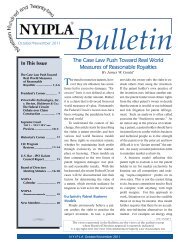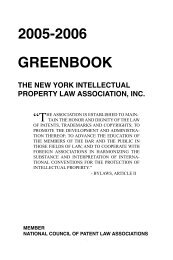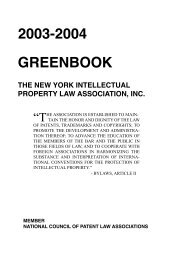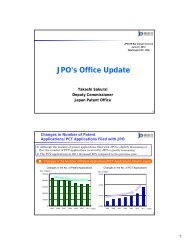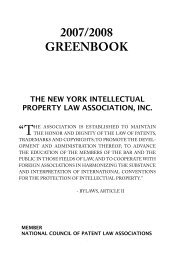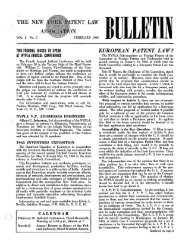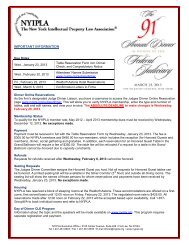Create successful ePaper yourself
Turn your PDF publications into a flip-book with our unique Google optimized e-Paper software.
The “Myriad” patent litigationPatentability of DNA moleculesPresentation to the SIPO DelegationSIPO/US Bar Liaison Council with ACPAAJoint Symposium at Cardozo Law SchoolNew York City, June 3, 20131Hans SauerBiotechnology Industry Organization
2Overview• A lawsuit by the American Civil Liberties Union, a well-known NewYork-based non-governmental civil rights organization– on behalf of several doctors who specialize in laboratory medicine, severalbreast cancer patients, genetic counselors, laboratory medicine organizations,and breast cancer patient advocacy groups.• Against Myriad Genetics Inc., a company in Salt Lake City, Utah,that provides genetic testing services for determining the risk ofhereditary breast and ovarian cancer in patients.*• To invalidate claims in Myriad’s patents to DNA molecules thatrelate to the BRCA1 and BRCA2 breast cancer genes.• There are several laboratories in the U.S. that offer limited testing ofthese genes, but only Myriad provides full, comprehensive testing.• The plaintiffs have said they want to break Myriad’s monopoly forBRCA1 and BRCA2 testing.* Myriad Genetics is not a member of BIO
3Examples of challenged claims• U.S. 5,747,282:1. An isolated DNA coding for a BRCA1 polypeptide, said polypeptidehaving the amino acid sequence set forth in SEQ ID NO:2.2. The isolated DNA of claim 1, wherein said DNA has the nucleotidesequence set forth in SEQ ID NO:1.• The challenged claims follow a 20 year-old standard format. This kindof claim is common in U.S. patents.• An estimated 8,700 unexpired U.S. patents contain at least 1 claim ofthis type.– 40% relate to use in human medicine– 60% relate to other fields, such as veterinary medicine, agriculture, foodand beverage manufacturing, industrial enzymes or bioenergyNature Biotechnology 31(5) (2013) 404-410.
4What kind of lawsuit is this?• Declaratory Judgment suit – a special kind of patent lawsuit where thepatent owner is the defendant.– An “attack first” lawsuit by someone who has not been sued forpatent infringement, but who feels harmed by the patent because,for example, they would likely be sued.– Requires an actual, underlying legal dispute between the parties.Not like nullity or revocation lawsuits in some countries.• Summary Judgment – the case was first decided under an abbreviatedprocedure requiring no examination of witnesses and limited facts.• Such lawsuits are sometimes difficult for the courts because they canbe somewhat abstract and hypothetical. There may be no actualinfringing activity to which the claims can be compared. The courts haveless information than in an infringement lawsuit.
5Procedural history• March 29, 2010: U.S. District Court for the Southern District of NewYork holds claims invalid under Section 101 of the U.S. Patent Act• July 29, 2011: U.S. Court of Appeals for the Federal Circuit reversesthe lower court * Three judges write 3 separate opinions.• March 26, 2012: U.S. Supreme Court vacates the decision andremands for reconsideration in light of Mayo v. Prometheus 132 S.Ct.1289• August 16, 2012: U.S. Court of Appeals for the Federal Circuit againreverses the lower court’s decision. Again 3 judges write 3 opinions.• November 30, 2012: U.S. Supreme Court grants review.* The lower court had also struck down certain Myriad patent claims to broad and generalizedmethods of comparing BRCA DNA sequences. The invalidation of these method claimswas affirmed by the appellate court and is not discussed in this presentation.
6Legal theories (1)• The question is NOT novelty; unobviousness/inventive step; sufficiencyof technical disclosure; or utility/industrial applicability.• Patent-eligible subject matter: “Whoever invents or discovers any newand useful process, machine, manufacture, or composition of matter, orany new and useful improvement thereof… subject to the conditions andrequirements of [the Patent Act]” 35 USC 101.• Suggests that courts should ask: “is the patent claim directed tosomething that was ‘composed’ or ‘manufactured’ or ‘improved’ by man?”• For example:– “a new mineral found in the earth” was not ‘composed’ by man; or “a new plant foundin the wild” was not ‘manufactured’ by man – neither would be patentable. Diamond v.Chakrabarty 447 U.S. 303 (1980)– “A signal with embedded supplemental data” is not patentable because a “signal” is nota process; a machine; a manufactured article; or a composition of matter. In re Nuijten500 F.3d 1346 (Fed. Cir, 2007).
7Legal theories (2)• But: historically, the U.S. Supreme Court has sometimes applied rulesfrom its own earlier cases, even if they’re not part of the “conditions andrequirements” of the Patent Act.• Under U.S. Supreme Court law, “laws of nature, physical phenomena, orabstract ideas” are excluded from patentable subject matter.• The Supreme Court has applied and developed this exception for“manifestations of nature” in at least 5 cases between 1972 and 2012.These cases dealt with processes involving mathematical or logicaloperations.• Two of these cases were decided after the Myriad litigation started.• The Supreme Court’s exceptions have generated a large amount oflegal commentary, and many different opinions on how they should bepractically applied. (e.g. CLS Bank v. Alice, (Fed. Cir. May 10, 2013)(Seven different opinions by 10 judges).
8Arguments against patent-eligibility• The challengers say that isolated DNA molecules should fall under theexception for natural phenomena because genes exist in nature.• Isolated DNA molecules having natural sequences are not sufficientlydifferent from natural genes.• They have only been removed from their natural environment, butthey’re still the same.• The patentee hasn’t made them more useful.• The patentee has only discovered them, not invented them.• The “isolated DNA claims” interfere with scientific progress, becausethey prevent anyone from studying or using the natural gene.
9Arguments for patent-eligibility• The defenders say that isolated DNA molecules are not a naturalphenomenon because:• The patents don’t claim anything in anyone’s body.• Isolated DNA molecules are obtained in the laboratory and do not existin nature.• They are chemically quite different from natural genes.• They are useful for new technical applications that are not possible withnatural genes.• They required great technical and intellectual effort by scientists in orderto become known and available for human use.
10Remarks• The questions that need to be answered depend on many technical facts.They cannot be answered by just arguing about the law. For example:– “How different is the claimed isolated DNA molecule from a natural gene?”– “Would the patent claims always be infringed if someone did research on thenatural gene?”– “Does the claimed isolated DNA actually exist in nature?”• In the U.S., the technical facts in a lawsuit are established in the lowercourt (district court). No new facts can be added in the higher courts.• After the district court decided the Myriad case, the U.S. Supreme Courtdecided 2 other cases in this area of the law [Bilski v. Kappos (2010) andMayo v. Prometheus (2012)].• These cases influenced the legal questions about the Myriad case in thehigher courts, but no new technical facts could be added to answer them,thereby increasing confusion and disagreement during the appeals.
11Remarks (2)• The Myriad case involves a very broad legal question: Should an isolatedDNA molecule be excluded from patentability, even if it was not knownbefore, has been isolated from nature for the first time, and its structureand form is clearly characterized, and has practical value in industry?• Because of this broad legal question, the U.S. Supreme Court may find itvery hard to limit its decision to only Myriad’s patents. Its decision couldaffect many other patents:– If claims to isolated BRCA DNA are not patentable, claims to other isolatedhuman DNA would also not be patentable;– If claims to isolated human DNAs are not patentable, claims to isolatedanimal, plant, or microbial DNA would also not be patentable.– If claims to isolated DNA are not patentable, why would claims to otherisolated molecules be patentable? For example medicinal substances thatare isolated from plants?
12What about the public interest?“Patients don’t have access”“Patents increase prices”“Patents interfere with research andmedical care”“Myriad is a bad company”“What the other side is saying is not true”“Patents are needed for businessinvestment”“Patents create new and better products”“Patents create new businesses and jobs”“Myriad is a good company.”“What the other side is saying is not true”
13What about the public interest? (2)• Policy questions affect everyone. They cannot be decided in a lawsuitbetween only two parties.• That’s why judges rely on the law, not on policy, to decide whether apatent is valid or not.• For example:– If a patent owner is a “bad actor,” that doesn’t mean his patent is invalid.– If a consumer cannot get access to the patented product, that doesn’t meanthe patent is invalid.• But: The public interest is important . There is a tendency in U.S. patentlaw to preserve the public interest without destroying the patent rightaltogether. In fact, patent rights are also in the public interest, and mustbe balanced against other public interests.
14What about the public interest? (3)• For example: In 1995, Congress determined that it would be against thepublic interest if medical doctors could be sued for patent infringement forpracticing surgery.• It was first proposed to forbid all patents for doing surgical proceduresand administering medical therapies. But Congress decided to not bansuch patents. Instead, medical doctors were given immunity for certainpatent-infringing medical activities. 35 USC 287(c) (1996). This balancedthe public interests without destroying patents altogether.• For example: In the 1930s the City of Milwaukee operated a sewagetreatment facility that used a patented process for treating waste water.Even though there was an extraordinary public interest, the court foundthat the patent was both valid and infringed. The court decided that thepatent owner should be compensated financially, but that the plantshould not be shut down. Milwaukee v. Activated Sludge 69 F.2d 577
Public interest example: Amgen v. Roche15• Example: In Amgen v. Roche 581 F. Supp. 2d 160 (D. Mass 2008), afterpatents were found valid and infringed, the patent owner sought aninjunction to block a competing drug from entering the market.• Under U.S. patent law, a patent owner seeking such an order must prove– (1) that it would suffer an irreparable injury;– (2) that money payments would not be sufficient to compensate for the injury;– (3) that the balance of fairness and harm to both parties favors the patentee;and– (4) that the public interest would not be disserved by a permanent injunction.• The judge considered factors 1-3 in favor of the patent owner - but themain focus was on the public interest. The judge appointed a specialmaster and a technical expert and held 4 days of hearings to balance thepublic interest factors of: (i) patient health; (ii) medical cost savings and(iii) patent-based incentives for innovation.
Public interest example: Amgen v. Roche (2)16• Patient health: do existing treatments meet the medical needs ofpatients? The judge found that patients and doctors would probablybenefit from additional choice. But it was not clear that the infringing drugwould provide significant clinical advantages over existing treatments.• Medical cost savings: The judge found that market entry of the infringingdrug would not necessarily result in overall lower cost to public payors.Also, just because an infringing product is cheaper is not a good reason:A copied product can always be sold cheaper than the original.• Innovation: The judge stated that the breakthrough innovation was madeby the patent owner, and that the infringing drug was “just” animprovement of the patent owner’s existing drug. The public interest inbreakthrough innovations is stronger than the public interest in smallimprovements. Drug innovation is very time-consuming, risky, andexpensive, and strong patent rights are a very important incentive.
Public interest example: Amgen v. Roche (3)17• The Amgen case teaches us that public interest considerations get verycomplicated very quickly, and that a lot of facts must be considered inorder to make a reliable, evidence-based decision.• The judge in the Amgen case wrote that he at first wanted to allow theinfringing drug on the market. But after he had considered all the facts,he reached a different conclusion.• In the Amgen case, the judge appointed a neutral expert to explain thetechnical questions. He also appointed a special master (an officer of thecourt to manage especially complicated and difficult issues), and heardevidence during four full days of testimony.• In comparison, the judge in the Myriad case held a single two hourhearing on summary judgment motions.
Do patents interfere with basic research?18• The popular press is saying that patented things cannot be furtherresearched by others.• This theory is presented to support section 101 ineligibility even by somedepartments of the U.S. Government: important discoveries should beexcluded from patenting, because scientists and researchers must befree to work on them.• “Myriad and other gene patent holders have gained the right to excludethe rest of the scientific community from examining the naturallyoccurring genes of every person in the United States” [1]• “Any scientist who wants to conduct research on such a gene - even on asmall sequence of its DNA - has to pay license fees.” [2]• Such statements are often repeated in U.S. newspapers. However, theyare not true[1] Adam Liptak, Supreme Court to Look at a Gene Issue, N.Y. Times, Nov. 30, 2012[2] Michael Specter, Can We Patent Life?, The New Yorker, April 2, 2013
Do patents interfere with basic research? (2)19• The question whether patents interfere with basic research has beenstudied repeatedly. The National Academies, the American Associationfor the Advancement of Science, the Federal Trade Commission, andacademic scholars have concluded that there is little evidence thatpatents prevent scientists from doing research on patented inventions.• For example, the BRCA genes are among the most heavily studiedhuman genes. More than 5,000 scientific papers have been publishedsince 1998 by thousands of researchers without patent licenses.• The U.S. Patent Act does not have an explicit exception for basicexperimentation. But it is a very old principle that someone “whoconstructed a [patented] machine merely for [scientific] experiments orfor the purpose of ascertaining the sufficiency of the machine to produceits described effects” would not be held liable. Whittemore v. Cutter 29 F.Cas. 1120, 1121 (C.C.D. Mass. 1813).
Do patents interfere with basic research? (3)20• It is clear that there is an exception for scientific experimentation in U.S.patent law, but it is unclear how broad it is. Because there are nolawsuits about this question, judges have had almost no opportunity tomake the law clearer.• Judge Newman of the U.S. Court of Appeals for the Federal Circuitprovided an analysis according to which the following would not bepatent infringement under the “experimental use” exception*:– Experiments to understand how a patented invention works, and to verifywhether it does what the patentee says it does;– Experiments to improve a patented invention;– Experiments to determine whether a patented invention can be used in newways;– Experiments to compare a patented invention with alternatives.* CLS Bank v Alice Corp., 2011-1301, slip op., Fed Cir.May 10, 2013, Newman, J., concurring/dissenting in part
21Who should decide this question?• There are three sources of patent policy in the U.S.: The USPTO, thecourts, and Congress. Which one is best equipped to decide whetherisolated DNA molecules should be excluded from the patent system?• The USPTO: Has strong technical expertise. It receives input onregulations and guidelines through public notice-and-commentprocedures. The USPTO must consider public comments and explain itsconclusions and decisions. It can make limited policy, but is restricted bythe patent statute and higher court decisions. The USPTO is bestequipped to answer complicated technical questions that can be decidedwithin existing law.– For example, between 1999 and 2000 the USPTO went through a public commentprocess for DNA patents. In its final guidelines, the USPTO determined that patents onisolated DNA molecules do not claim a natural phenomenon, and can be permissibleunder patent law. However, the USPTO raised the standard by requiring such patentsto disclose a “specific, substantial, and credible utility.” Thousands of patentapplications were subsequently rejected under this standard.
22Who should decide this question? (2)• The courts: The courts have non-specialist judges. Almost none have ascientific or technical education. The courts decide particular disputesbetween two or more parties.• They are limited by the way the parties to a lawsuit define their dispute,and by the information and legal theories the parties put in the case.• The courts can receive public comments through “amicus briefs” butdon’t have to consider them.• The courts are equipped to decide particular disputes as defined by theparties, not to create “the best solution for everyone.”• Decisions can sometimes affect many other patent owners who are notpart of the lawsuit, and result in “policy.”
23Who should decide this question (3)• The Congress: Non-specialist legislators from a range of professionalbackgrounds. Congress receives wide input from other parts of theFederal Government, state governments, and many public stakeholders.Any member of the public can petition and be heard. Congress cancollect large amounts of facts to make decisions. It can change the law tocraft “the best solution for everybody.”– For example: In 1984, Bolar Pharmaceutical Co. argued to the U.S. Court ofAppeals for the Federal Circuit that an exception to patent infringementshould be created to resolve a conflict between the patent laws and the foodand drug laws. But the court replied that only Congress, not the court, has theability to “maximize public welfare through legislation.” 733 F.2d 858 (1984).– Later that year, Congress passed the Hatch-Waxman Act, which created aspecial infringement exception, but it also compensated patent holders withadditional patent term restoration. The USPTO or the courts could not havecreated such a solution.
24What could this case mean?• It is too soon to tell. The Supreme Court may be looking for a way todecide this case on narrow grounds. But it could be difficult to decide thiscase without affecting many other patents.• The Myriad case is not just about Myriad’s patents. It’s about a wholecategory of patents. If patents on isolated BRCA DNA molecules areinvalid because human BRCA genes exist naturally, then:– How can patents on other isolated DNA molecules with human sequences be valid?– How can patents on isolated DNA with animal, plant, or bacterial sequences be valid?– How can patents on other isolated substances from natural sources be valid, e.g.pharmaceutical substances from plants, antibiotics from fungi, enzymes from bacteria?• The majority of companies that own such patents work on medicines,agriculture, bioenergy, or industrial biotechnology. Very few providediagnostic testing services.• This case focuses only on the behavior of a single company, but manyother companies would be affected.
25What could this case mean? (2)• It is difficult to predict what this case could mean for patients or medicalcare. Myriad has hundreds of other patent claims that are not in thiscase. Even if the Supreme Court decides in favor of the ACLU, there willnot be complete freedom-to-operate.• It is unlikely that the prices for diagnostic testing will generally decrease.Researchers have found that the price of genetic tests depends not onpatents, but on how complicated the test is, and on the reimbursementrates set by insurance companies.• The cost or BRCA testing is around $3,800 – approximately the cost ofan MRI scan. Health insurance companies already widely pay for BRCAtesting.• But insurance companies will only pay if the test is medically necessaryaccording to their medical guidelines. This is normally the reason why apatient cannot have the test.
Thank you!Hans Sauerhsauer@bio.org26



